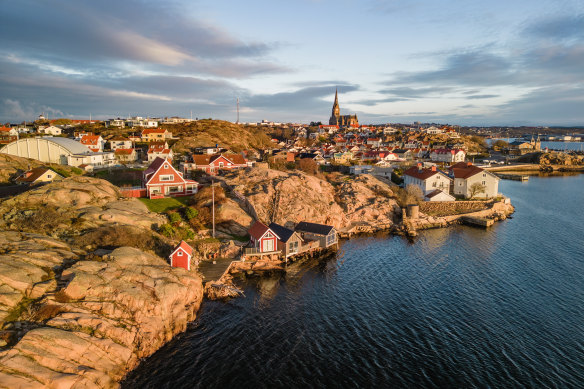Despite Russia conflict, cruisers can’t get enough of this region
The boycott of Russia following the invasion of Ukraine heightened fears over the viability of cruises in the Baltic Sea. Cruise ships stopped visiting St Petersburg, a highlight that entices passengers to take Baltic cruises. Ships often lingered there for two or even three days.
Those fears now seem unfounded as Baltic cruises flourish. Norwegian Cruise Line Holdings expects passenger demand to rise 18 per cent next year across its three brands (Norwegian, Regent Seven Seas and Oceania). Princess Cruises will homeport Sapphire Princess in Copenhagen in 2026, from where it will operate 12-day cruises.

The old town and coastline of Lysekil, Sweden.Credit: iStock
Northern Europe is already the third most popular cruise destination after the Caribbean and Mediterranean, with about 10 per cent of the overall market. Copenhagen and Kiel are the busiest ports, although few English-speaking cruises visit Kiel, a major homeport for German cruise lines. Some 150 ships sail there, the big players being AIDA Cruises, MSC Cruises and P&O Cruises UK, each of which operate multiple ships in the region.
Just about every mainstream and expedition cruise line operates in northern Europe where, following the success of winter cruises in Norway, they have been steadily lengthening their Baltic seasons.
Ponant’s Le Commandant Charcot, for example, will be sailing the region between December 2024 and March 2025, with some itineraries focusing on Christmas market experiences. It won’t be alone. Copenhagen now receives cruise calls year-round, with more than 50 expected between October 2024 and April 2025.
It isn’t hard to work out why the Baltic is booming despite the absence of St Petersburg visits. The region has efficient port infrastructure while many cities have wonderful water-and-island settings, relaxed lifestyles and distinctive Nordic style.
Stockholm, Copenhagen, Helsinki and Gdansk have a rich history and culture; they are safe and easy to explore.
Cruises have also started visiting smaller destinations such as the island of Saaremaa in Estonia, and Turku in Finland. New destination Lysekil in Sweden is courting the cruise market.
Aarhus in Denmark has seen a 40 per cent increase in passenger arrivals this year, Klaipeda in Lithuania 41 per cent, Turku in Finland 133 per cent, according to Cruise Baltic, which promotes a network of 32 regional ports. Smaller ports such as Nyborg, Skagen and Helsingborg in Denmark are also on the rise.
The Baltic’s islands are just as interesting. Gotland was a Viking stronghold and grew rich on medieval trade; ships call at Visby, encircled in walls and 44 towers and perhaps the prettiest town in all Sweden.
Danish fishing island Bornholm has a wild landscape of moors and forests. Ships dock at Ronne, a colourful old town whose church is dedicated to seafarers. Ronne is currently expanding its cruise quay to meet demand, as more travellers than ever set their sights on sailing the Baltic.
Sign up for the Traveller Deals newsletter
Get exclusive travel deals delivered straight to your inbox. Sign up now.